9th Commerce Lesson Plans: Consumer Choice & Protection - ACU 2019
VerifiedAdded on 2023/04/07
|16
|1901
|266
Practical Assignment
AI Summary
This assignment provides a series of lesson plans designed for a 9th-grade commerce class, focusing on consumer choice and protection. The lesson plans cover topics such as decisions affecting the quality of life, consumer decisions, comparison shopping, factors influencing consumer choices, consumer protection, features of a simple contract, legal rights, and the process of consumer redress. The lesson plans incorporate various teaching strategies, including class discussions, group activities, internet research, and textbook exercises, to engage students and facilitate their understanding of key concepts. The assignment also emphasizes the importance of authentic learning, encouraging students to develop real-life skills through projects and investigations. The lesson plans are aligned with syllabus outcomes and indicators of learning, with assessment strategies included to monitor student progress. Desklib offers a wealth of similar solved assignments and past papers to support students in their academic journey.
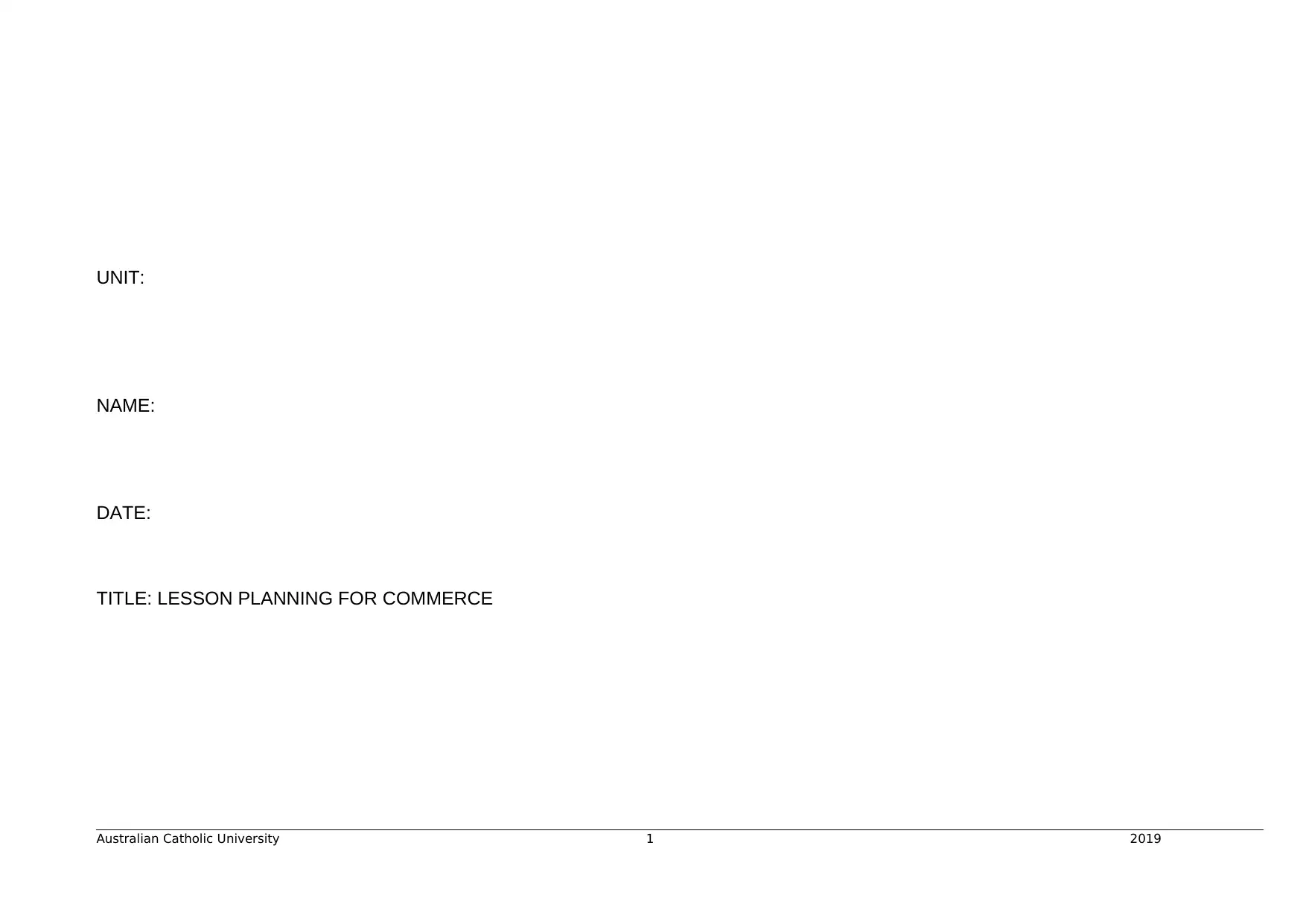
UNIT:
NAME:
DATE:
TITLE: LESSON PLANNING FOR COMMERCE
Australian Catholic University 1 2019
NAME:
DATE:
TITLE: LESSON PLANNING FOR COMMERCE
Australian Catholic University 1 2019
Paraphrase This Document
Need a fresh take? Get an instant paraphrase of this document with our AI Paraphraser

LESSON PLAN 1
Lesson Plan Format
Class: 9 Commerce 1 Date:18th March 2019 Time: Start:
____9:00AM__________________
Finish:
_____9:50AM__________________
Key Learning Area: Consumer Choice Lesson Topic: Commerce and Choice
Recent Prior Experience (specific relevant concepts, skills and values the school students have experienced prior to this lesson):
Promotion and Selling
Our Economy
Running a business
Syllabus Outcome(s):
One or two only. Please note the
syllabus reference number AND
write out in full.
5.1 applies consumer, financial,
business, legal and
employment concepts and
Indicators of Learning for this lesson:
Behaviors that contribute toward achievement of
outcome(s). Quote syllabus numbers. Must be clear,
specific, observable. Curriculum Content Strands
may be used as headings.
By the end of this lesson, the students will learn about:
- Decisions affecting the quality of people’s lives:
Assessment:
Strategies which will be used to
assess learners’ attainment of
learning outcomes. Should be linked
to each learning indicator.
-Text Book Questions
Australian Catholic University 2 2019
Lesson Plan Format
Class: 9 Commerce 1 Date:18th March 2019 Time: Start:
____9:00AM__________________
Finish:
_____9:50AM__________________
Key Learning Area: Consumer Choice Lesson Topic: Commerce and Choice
Recent Prior Experience (specific relevant concepts, skills and values the school students have experienced prior to this lesson):
Promotion and Selling
Our Economy
Running a business
Syllabus Outcome(s):
One or two only. Please note the
syllabus reference number AND
write out in full.
5.1 applies consumer, financial,
business, legal and
employment concepts and
Indicators of Learning for this lesson:
Behaviors that contribute toward achievement of
outcome(s). Quote syllabus numbers. Must be clear,
specific, observable. Curriculum Content Strands
may be used as headings.
By the end of this lesson, the students will learn about:
- Decisions affecting the quality of people’s lives:
Assessment:
Strategies which will be used to
assess learners’ attainment of
learning outcomes. Should be linked
to each learning indicator.
-Text Book Questions
Australian Catholic University 2 2019

terminology in a variety of
contexts
5.4 analyses key factors affecting
commercial and legal decisions
-
-
Consumer
Financial
Business
Legal
Employement
Environment
- Class Discussion
- Quiz
-Monitoring oral contribution about
commerce
-
Any safety issues to be considered:
Setting up: Students moving around
Resources:
List resources you used in the lesson implementation.
Textbook
Execution booklet
Website
Video
Handout
LESSON SEQUENCE
Lesson Content / Indicators of
Learning (What is Taught):
Note key skills, concepts and values
Timing
(mins)
50min
Teaching Strategies / Learning Experiences:
(How it is taught)
Write detailed steps showing what the teacher (T)
Resources and
Organisation:
Australian Catholic University 3 2019
contexts
5.4 analyses key factors affecting
commercial and legal decisions
-
-
Consumer
Financial
Business
Legal
Employement
Environment
- Class Discussion
- Quiz
-Monitoring oral contribution about
commerce
-
Any safety issues to be considered:
Setting up: Students moving around
Resources:
List resources you used in the lesson implementation.
Textbook
Execution booklet
Website
Video
Handout
LESSON SEQUENCE
Lesson Content / Indicators of
Learning (What is Taught):
Note key skills, concepts and values
Timing
(mins)
50min
Teaching Strategies / Learning Experiences:
(How it is taught)
Write detailed steps showing what the teacher (T)
Resources and
Organisation:
Australian Catholic University 3 2019
⊘ This is a preview!⊘
Do you want full access?
Subscribe today to unlock all pages.

Trusted by 1+ million students worldwide
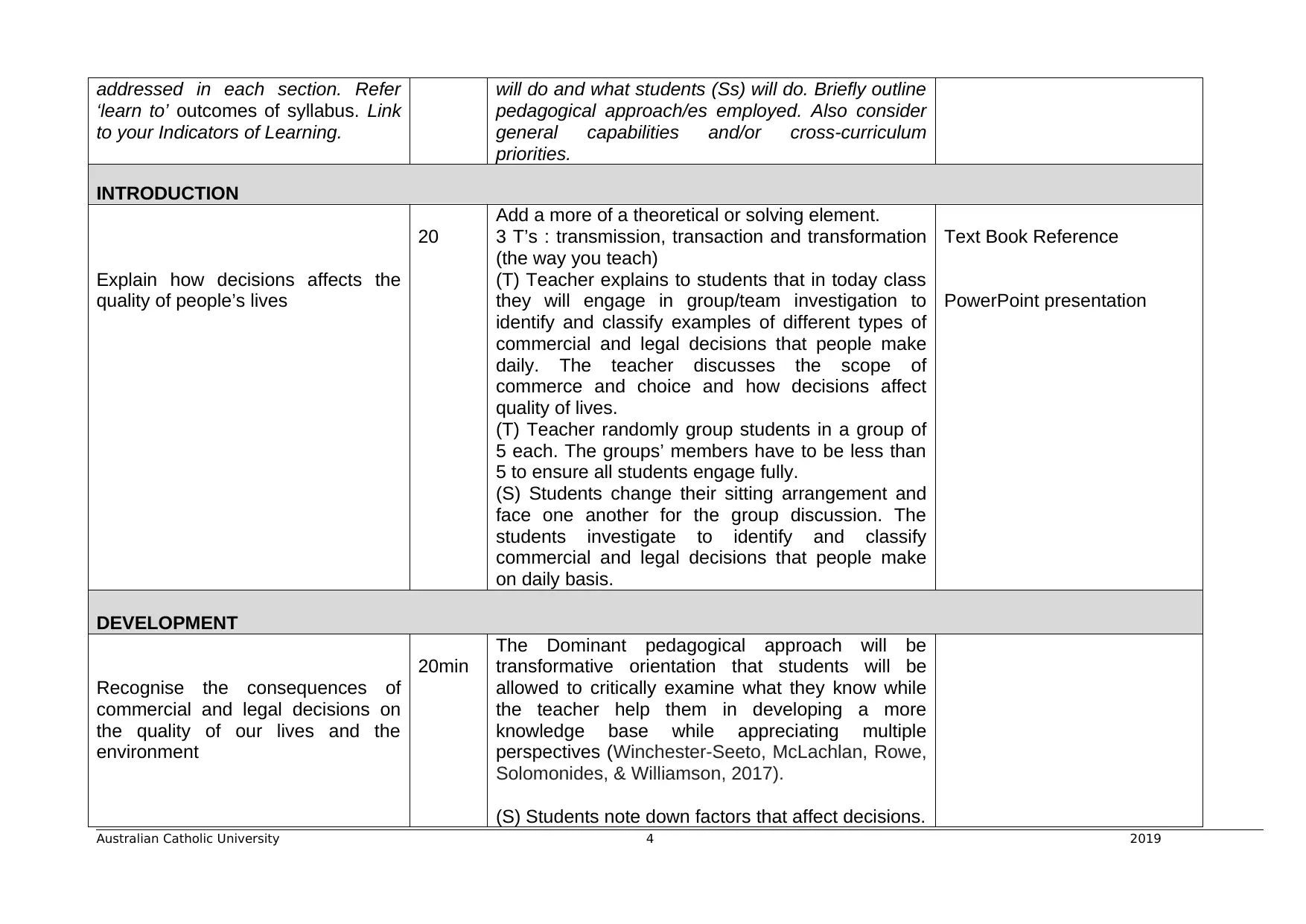
addressed in each section. Refer
‘learn to’ outcomes of syllabus. Link
to your Indicators of Learning.
will do and what students (Ss) will do. Briefly outline
pedagogical approach/es employed. Also consider
general capabilities and/or cross-curriculum
priorities.
INTRODUCTION
Explain how decisions affects the
quality of people’s lives
20
Add a more of a theoretical or solving element.
3 T’s : transmission, transaction and transformation
(the way you teach)
(T) Teacher explains to students that in today class
they will engage in group/team investigation to
identify and classify examples of different types of
commercial and legal decisions that people make
daily. The teacher discusses the scope of
commerce and choice and how decisions affect
quality of lives.
(T) Teacher randomly group students in a group of
5 each. The groups’ members have to be less than
5 to ensure all students engage fully.
(S) Students change their sitting arrangement and
face one another for the group discussion. The
students investigate to identify and classify
commercial and legal decisions that people make
on daily basis.
Text Book Reference
PowerPoint presentation
DEVELOPMENT
Recognise the consequences of
commercial and legal decisions on
the quality of our lives and the
environment
20min
The Dominant pedagogical approach will be
transformative orientation that students will be
allowed to critically examine what they know while
the teacher help them in developing a more
knowledge base while appreciating multiple
perspectives (Winchester-Seeto, McLachlan, Rowe,
Solomonides, & Williamson, 2017).
(S) Students note down factors that affect decisions.
Australian Catholic University 4 2019
‘learn to’ outcomes of syllabus. Link
to your Indicators of Learning.
will do and what students (Ss) will do. Briefly outline
pedagogical approach/es employed. Also consider
general capabilities and/or cross-curriculum
priorities.
INTRODUCTION
Explain how decisions affects the
quality of people’s lives
20
Add a more of a theoretical or solving element.
3 T’s : transmission, transaction and transformation
(the way you teach)
(T) Teacher explains to students that in today class
they will engage in group/team investigation to
identify and classify examples of different types of
commercial and legal decisions that people make
daily. The teacher discusses the scope of
commerce and choice and how decisions affect
quality of lives.
(T) Teacher randomly group students in a group of
5 each. The groups’ members have to be less than
5 to ensure all students engage fully.
(S) Students change their sitting arrangement and
face one another for the group discussion. The
students investigate to identify and classify
commercial and legal decisions that people make
on daily basis.
Text Book Reference
PowerPoint presentation
DEVELOPMENT
Recognise the consequences of
commercial and legal decisions on
the quality of our lives and the
environment
20min
The Dominant pedagogical approach will be
transformative orientation that students will be
allowed to critically examine what they know while
the teacher help them in developing a more
knowledge base while appreciating multiple
perspectives (Winchester-Seeto, McLachlan, Rowe,
Solomonides, & Williamson, 2017).
(S) Students note down factors that affect decisions.
Australian Catholic University 4 2019
Paraphrase This Document
Need a fresh take? Get an instant paraphrase of this document with our AI Paraphraser
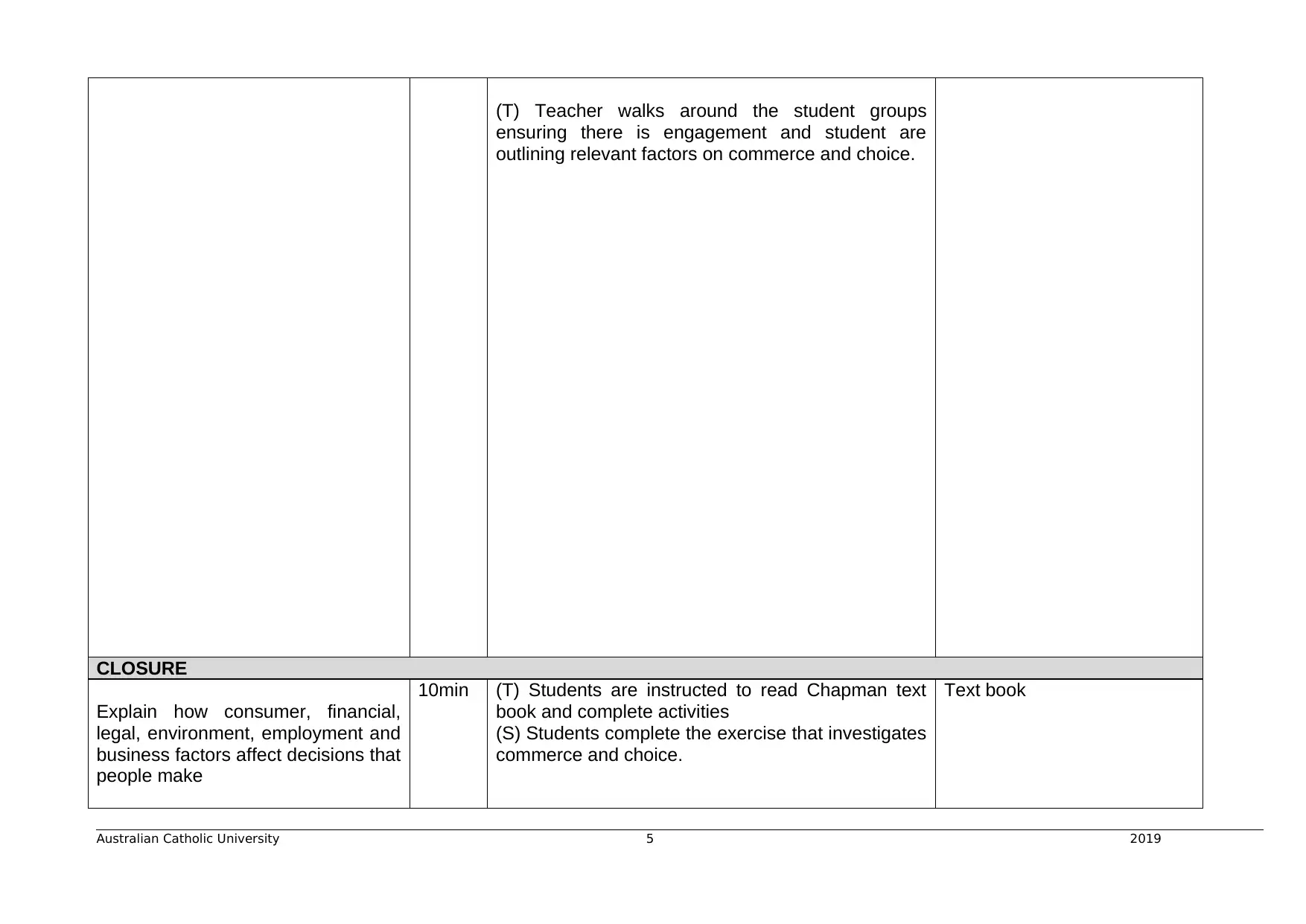
(T) Teacher walks around the student groups
ensuring there is engagement and student are
outlining relevant factors on commerce and choice.
CLOSURE
Explain how consumer, financial,
legal, environment, employment and
business factors affect decisions that
people make
10min (T) Students are instructed to read Chapman text
book and complete activities
(S) Students complete the exercise that investigates
commerce and choice.
Text book
Australian Catholic University 5 2019
ensuring there is engagement and student are
outlining relevant factors on commerce and choice.
CLOSURE
Explain how consumer, financial,
legal, environment, employment and
business factors affect decisions that
people make
10min (T) Students are instructed to read Chapman text
book and complete activities
(S) Students complete the exercise that investigates
commerce and choice.
Text book
Australian Catholic University 5 2019
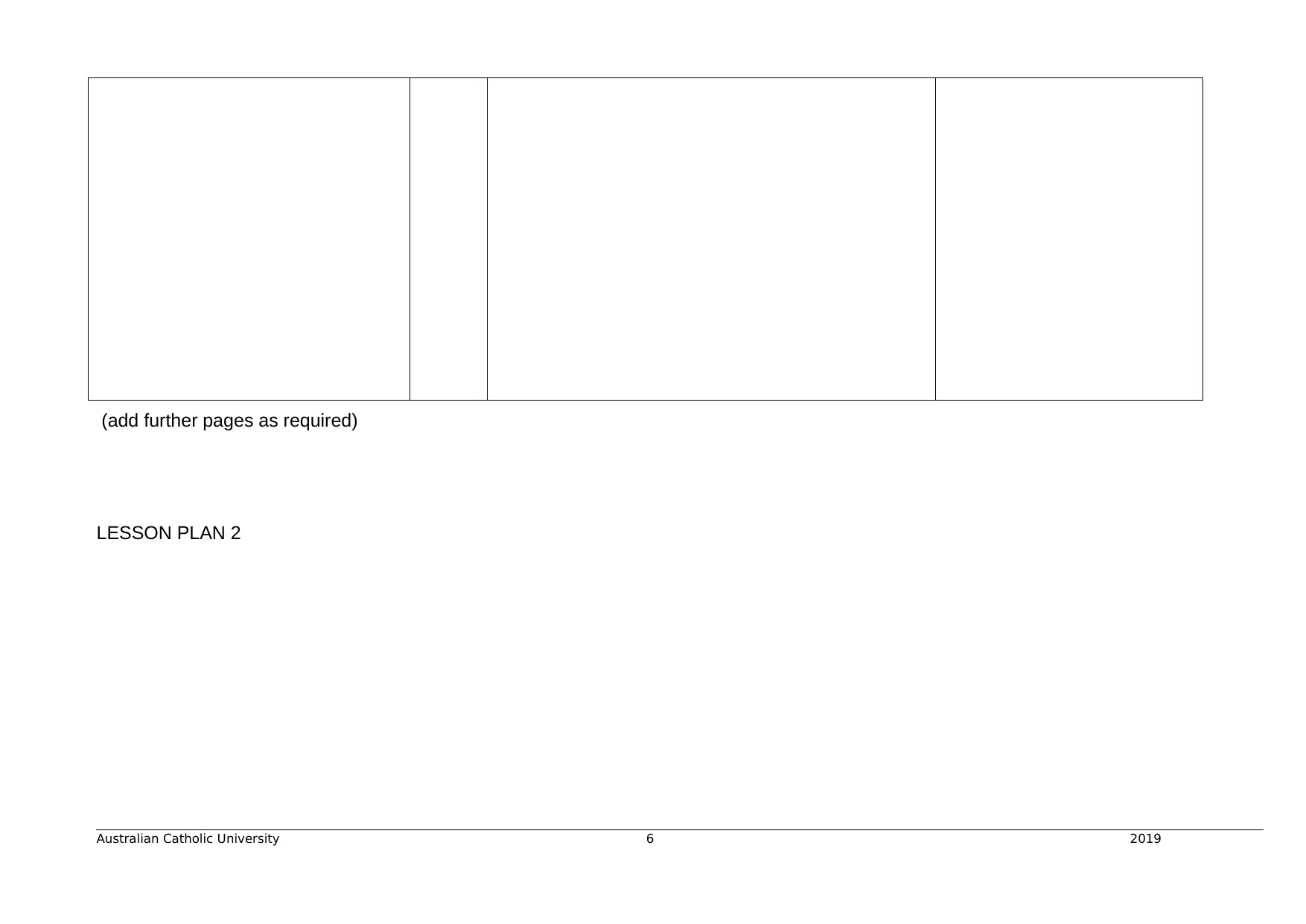
(add further pages as required)
LESSON PLAN 2
Australian Catholic University 6 2019
LESSON PLAN 2
Australian Catholic University 6 2019
⊘ This is a preview!⊘
Do you want full access?
Subscribe today to unlock all pages.

Trusted by 1+ million students worldwide
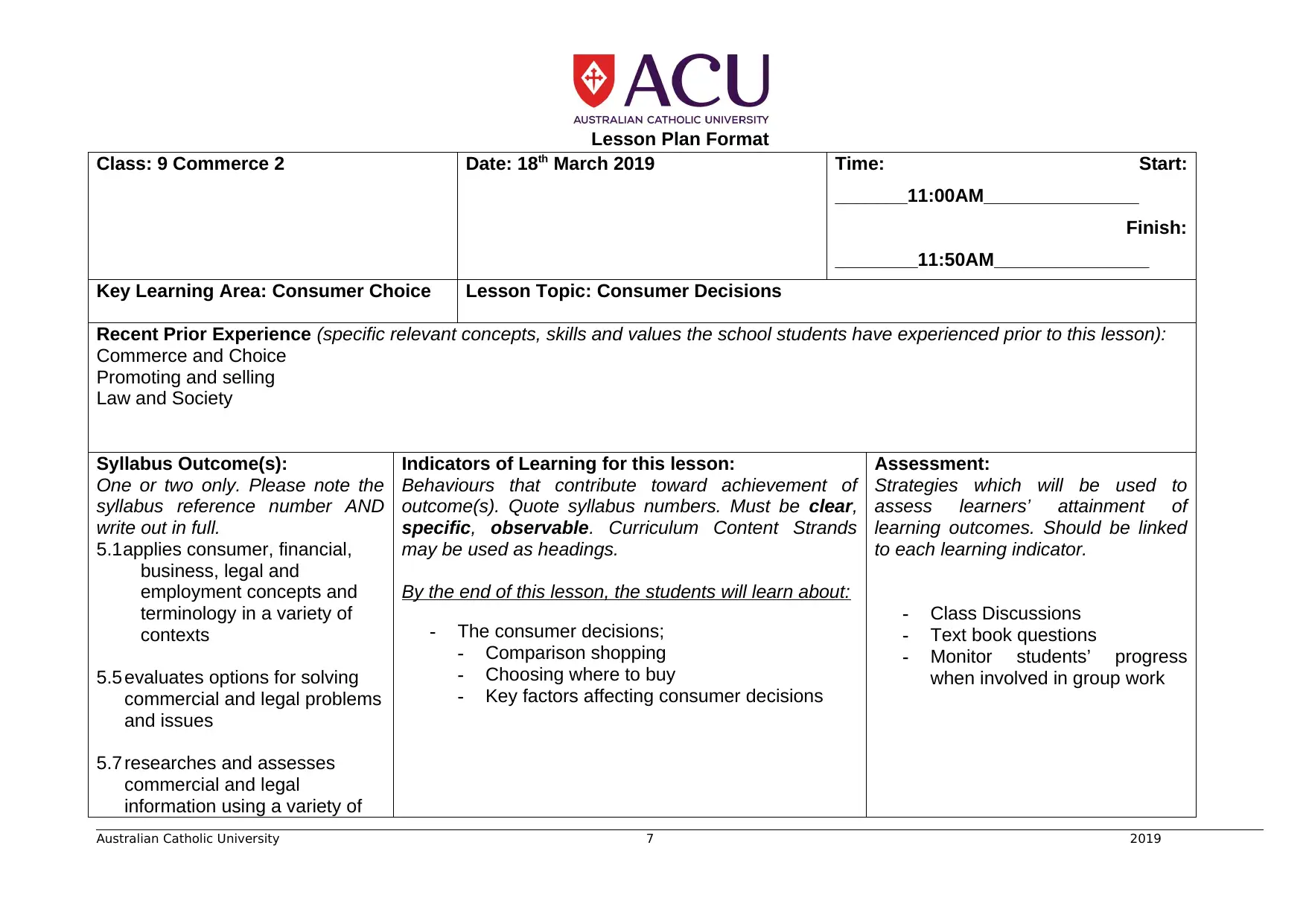
Lesson Plan Format
Class: 9 Commerce 2 Date: 18th March 2019 Time: Start:
_______11:00AM_______________
Finish:
________11:50AM_______________
Key Learning Area: Consumer Choice Lesson Topic: Consumer Decisions
Recent Prior Experience (specific relevant concepts, skills and values the school students have experienced prior to this lesson):
Commerce and Choice
Promoting and selling
Law and Society
Syllabus Outcome(s):
One or two only. Please note the
syllabus reference number AND
write out in full.
5.1applies consumer, financial,
business, legal and
employment concepts and
terminology in a variety of
contexts
5.5 evaluates options for solving
commercial and legal problems
and issues
5.7 researches and assesses
commercial and legal
information using a variety of
Indicators of Learning for this lesson:
Behaviours that contribute toward achievement of
outcome(s). Quote syllabus numbers. Must be clear,
specific, observable. Curriculum Content Strands
may be used as headings.
By the end of this lesson, the students will learn about:
- The consumer decisions;
- Comparison shopping
- Choosing where to buy
- Key factors affecting consumer decisions
Assessment:
Strategies which will be used to
assess learners’ attainment of
learning outcomes. Should be linked
to each learning indicator.
- Class Discussions
- Text book questions
- Monitor students’ progress
when involved in group work
Australian Catholic University 7 2019
Class: 9 Commerce 2 Date: 18th March 2019 Time: Start:
_______11:00AM_______________
Finish:
________11:50AM_______________
Key Learning Area: Consumer Choice Lesson Topic: Consumer Decisions
Recent Prior Experience (specific relevant concepts, skills and values the school students have experienced prior to this lesson):
Commerce and Choice
Promoting and selling
Law and Society
Syllabus Outcome(s):
One or two only. Please note the
syllabus reference number AND
write out in full.
5.1applies consumer, financial,
business, legal and
employment concepts and
terminology in a variety of
contexts
5.5 evaluates options for solving
commercial and legal problems
and issues
5.7 researches and assesses
commercial and legal
information using a variety of
Indicators of Learning for this lesson:
Behaviours that contribute toward achievement of
outcome(s). Quote syllabus numbers. Must be clear,
specific, observable. Curriculum Content Strands
may be used as headings.
By the end of this lesson, the students will learn about:
- The consumer decisions;
- Comparison shopping
- Choosing where to buy
- Key factors affecting consumer decisions
Assessment:
Strategies which will be used to
assess learners’ attainment of
learning outcomes. Should be linked
to each learning indicator.
- Class Discussions
- Text book questions
- Monitor students’ progress
when involved in group work
Australian Catholic University 7 2019
Paraphrase This Document
Need a fresh take? Get an instant paraphrase of this document with our AI Paraphraser
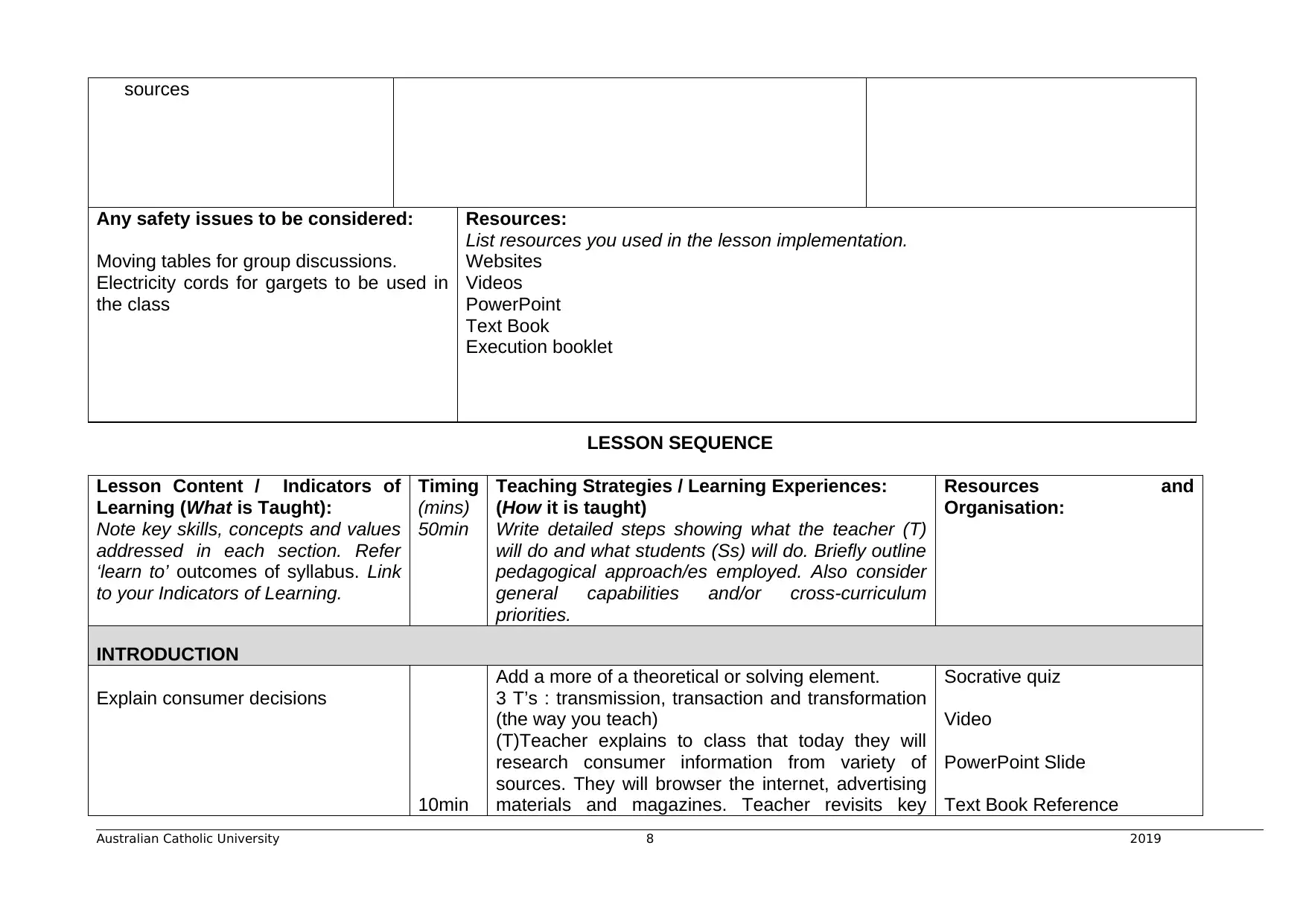
sources
Any safety issues to be considered:
Moving tables for group discussions.
Electricity cords for gargets to be used in
the class
Resources:
List resources you used in the lesson implementation.
Websites
Videos
PowerPoint
Text Book
Execution booklet
LESSON SEQUENCE
Lesson Content / Indicators of
Learning (What is Taught):
Note key skills, concepts and values
addressed in each section. Refer
‘learn to’ outcomes of syllabus. Link
to your Indicators of Learning.
Timing
(mins)
50min
Teaching Strategies / Learning Experiences:
(How it is taught)
Write detailed steps showing what the teacher (T)
will do and what students (Ss) will do. Briefly outline
pedagogical approach/es employed. Also consider
general capabilities and/or cross-curriculum
priorities.
Resources and
Organisation:
INTRODUCTION
Explain consumer decisions
10min
Add a more of a theoretical or solving element.
3 T’s : transmission, transaction and transformation
(the way you teach)
(T)Teacher explains to class that today they will
research consumer information from variety of
sources. They will browser the internet, advertising
materials and magazines. Teacher revisits key
Socrative quiz
Video
PowerPoint Slide
Text Book Reference
Australian Catholic University 8 2019
Any safety issues to be considered:
Moving tables for group discussions.
Electricity cords for gargets to be used in
the class
Resources:
List resources you used in the lesson implementation.
Websites
Videos
PowerPoint
Text Book
Execution booklet
LESSON SEQUENCE
Lesson Content / Indicators of
Learning (What is Taught):
Note key skills, concepts and values
addressed in each section. Refer
‘learn to’ outcomes of syllabus. Link
to your Indicators of Learning.
Timing
(mins)
50min
Teaching Strategies / Learning Experiences:
(How it is taught)
Write detailed steps showing what the teacher (T)
will do and what students (Ss) will do. Briefly outline
pedagogical approach/es employed. Also consider
general capabilities and/or cross-curriculum
priorities.
Resources and
Organisation:
INTRODUCTION
Explain consumer decisions
10min
Add a more of a theoretical or solving element.
3 T’s : transmission, transaction and transformation
(the way you teach)
(T)Teacher explains to class that today they will
research consumer information from variety of
sources. They will browser the internet, advertising
materials and magazines. Teacher revisits key
Socrative quiz
Video
PowerPoint Slide
Text Book Reference
Australian Catholic University 8 2019

points that were learnt in the previous lesson of
commerce and choice on how decisions affect the
quality of life.
(T) Teacher shows video and images containing
consumer information.
(S) Students join a partner to reflect on consumer
information and examine the role of consumer
information in consumer decisions.
Internet connection
DEVELOPMENT
Explain factors influencing decisions
15
20
The dominant pedagogy approach is transmission
orientation as the teacher is highly engaged to
transmit knowledge on the concepts that influence
consumer decisions (Pluss, 2018).
(T) Teacher present advertising materials and
instructs students to research online for consumer
information.
(S) Students browse the internet and present
consumer information.
Research commences
(T) Teacher helps students who are unable to locate
consumer information.
Quiz
Australian Catholic University 9 2019
commerce and choice on how decisions affect the
quality of life.
(T) Teacher shows video and images containing
consumer information.
(S) Students join a partner to reflect on consumer
information and examine the role of consumer
information in consumer decisions.
Internet connection
DEVELOPMENT
Explain factors influencing decisions
15
20
The dominant pedagogy approach is transmission
orientation as the teacher is highly engaged to
transmit knowledge on the concepts that influence
consumer decisions (Pluss, 2018).
(T) Teacher present advertising materials and
instructs students to research online for consumer
information.
(S) Students browse the internet and present
consumer information.
Research commences
(T) Teacher helps students who are unable to locate
consumer information.
Quiz
Australian Catholic University 9 2019
⊘ This is a preview!⊘
Do you want full access?
Subscribe today to unlock all pages.

Trusted by 1+ million students worldwide

CLOSURE
Explain factors that affect consumer
decisions and examine factors which
contribute to change in behaviour
and practice by consumers.
5min
(T) Teacher instructs students to read Chapman
text book on the topic and undertake the activities at
the end of the reading.
(S) Student complete the activity exercise that
examines consumer decision
scaffolded handout
(add further pages as required)
Australian Catholic University 10 2019
Explain factors that affect consumer
decisions and examine factors which
contribute to change in behaviour
and practice by consumers.
5min
(T) Teacher instructs students to read Chapman
text book on the topic and undertake the activities at
the end of the reading.
(S) Student complete the activity exercise that
examines consumer decision
scaffolded handout
(add further pages as required)
Australian Catholic University 10 2019
Paraphrase This Document
Need a fresh take? Get an instant paraphrase of this document with our AI Paraphraser
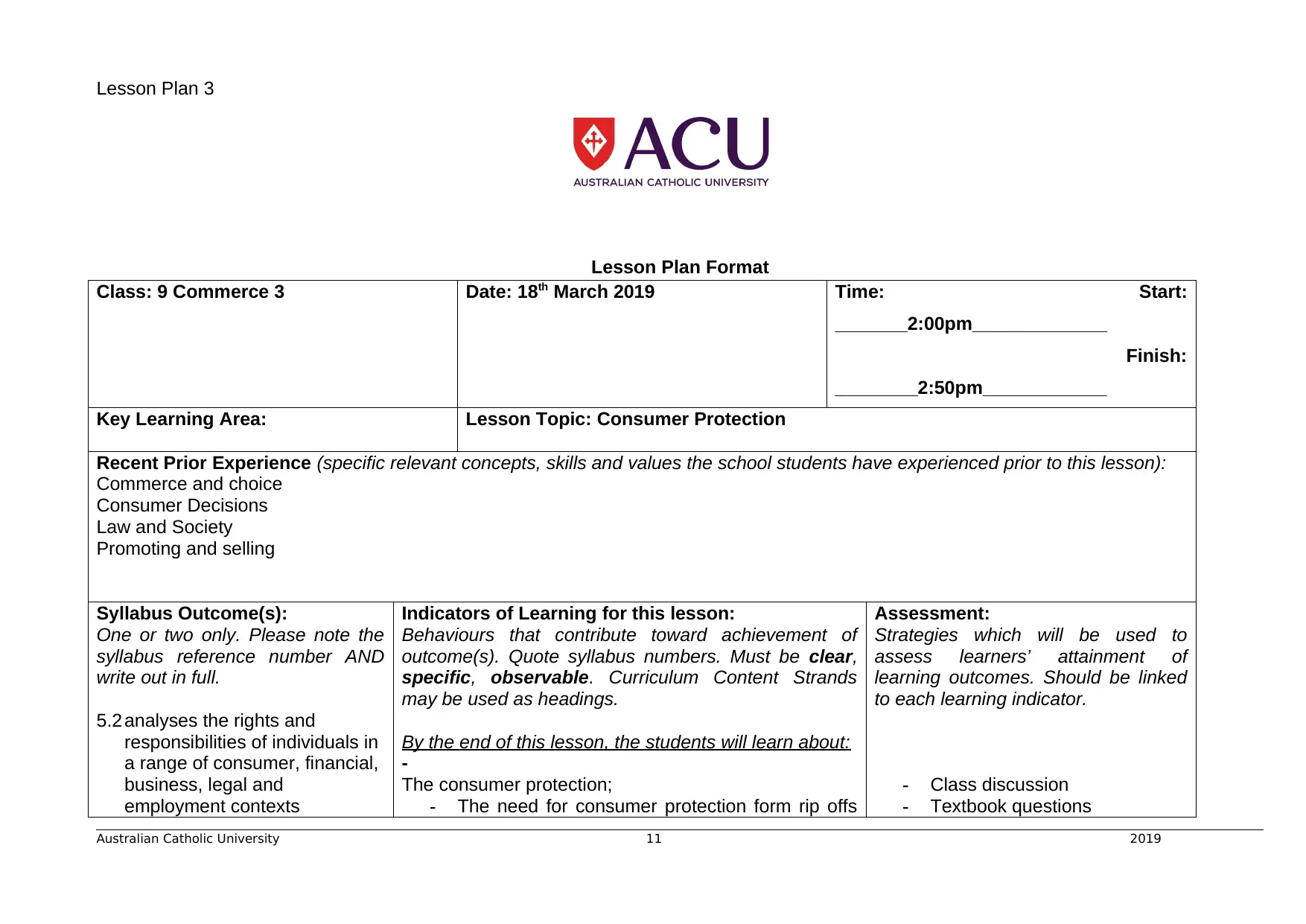
Lesson Plan 3
Lesson Plan Format
Class: 9 Commerce 3 Date: 18th March 2019 Time: Start:
_______2:00pm_____________
Finish:
________2:50pm____________
Key Learning Area: Lesson Topic: Consumer Protection
Recent Prior Experience (specific relevant concepts, skills and values the school students have experienced prior to this lesson):
Commerce and choice
Consumer Decisions
Law and Society
Promoting and selling
Syllabus Outcome(s):
One or two only. Please note the
syllabus reference number AND
write out in full.
5.2 analyses the rights and
responsibilities of individuals in
a range of consumer, financial,
business, legal and
employment contexts
Indicators of Learning for this lesson:
Behaviours that contribute toward achievement of
outcome(s). Quote syllabus numbers. Must be clear,
specific, observable. Curriculum Content Strands
may be used as headings.
By the end of this lesson, the students will learn about:
-
The consumer protection;
- The need for consumer protection form rip offs
Assessment:
Strategies which will be used to
assess learners’ attainment of
learning outcomes. Should be linked
to each learning indicator.
- Class discussion
- Textbook questions
Australian Catholic University 11 2019
Lesson Plan Format
Class: 9 Commerce 3 Date: 18th March 2019 Time: Start:
_______2:00pm_____________
Finish:
________2:50pm____________
Key Learning Area: Lesson Topic: Consumer Protection
Recent Prior Experience (specific relevant concepts, skills and values the school students have experienced prior to this lesson):
Commerce and choice
Consumer Decisions
Law and Society
Promoting and selling
Syllabus Outcome(s):
One or two only. Please note the
syllabus reference number AND
write out in full.
5.2 analyses the rights and
responsibilities of individuals in
a range of consumer, financial,
business, legal and
employment contexts
Indicators of Learning for this lesson:
Behaviours that contribute toward achievement of
outcome(s). Quote syllabus numbers. Must be clear,
specific, observable. Curriculum Content Strands
may be used as headings.
By the end of this lesson, the students will learn about:
-
The consumer protection;
- The need for consumer protection form rip offs
Assessment:
Strategies which will be used to
assess learners’ attainment of
learning outcomes. Should be linked
to each learning indicator.
- Class discussion
- Textbook questions
Australian Catholic University 11 2019

5.5 evaluates options for solving
commercial and legal problems
and issues
5.9 works independently and
collaboratively to meet individual
and collective goals within
specified timelines
-
and scams
- Features of a simple contract
- Legal rights and protective legislation for
consumer
- The process of consumer redress
- Monitoring progress when
involved in group activity.
- Quiz about consumer
protection
Any safety issues to be considered:
Setting up: Moving table for group
discussion and electricity cords can get
damaged
Resources:
List resources you used in the lesson implementation.
Internet connection
Textbook
Execution booklet
PowerPoint Slide
LESSON SEQUENCE
Lesson Content / Indicators of
Learning (What is Taught):
Timing
(mins)
Teaching Strategies / Learning Experiences:
(How it is taught)
Resources and
Organisation:
Australian Catholic University 12 2019
commercial and legal problems
and issues
5.9 works independently and
collaboratively to meet individual
and collective goals within
specified timelines
-
and scams
- Features of a simple contract
- Legal rights and protective legislation for
consumer
- The process of consumer redress
- Monitoring progress when
involved in group activity.
- Quiz about consumer
protection
Any safety issues to be considered:
Setting up: Moving table for group
discussion and electricity cords can get
damaged
Resources:
List resources you used in the lesson implementation.
Internet connection
Textbook
Execution booklet
PowerPoint Slide
LESSON SEQUENCE
Lesson Content / Indicators of
Learning (What is Taught):
Timing
(mins)
Teaching Strategies / Learning Experiences:
(How it is taught)
Resources and
Organisation:
Australian Catholic University 12 2019
⊘ This is a preview!⊘
Do you want full access?
Subscribe today to unlock all pages.

Trusted by 1+ million students worldwide
1 out of 16
Related Documents
Your All-in-One AI-Powered Toolkit for Academic Success.
+13062052269
info@desklib.com
Available 24*7 on WhatsApp / Email
![[object Object]](/_next/static/media/star-bottom.7253800d.svg)
Unlock your academic potential
Copyright © 2020–2025 A2Z Services. All Rights Reserved. Developed and managed by ZUCOL.





